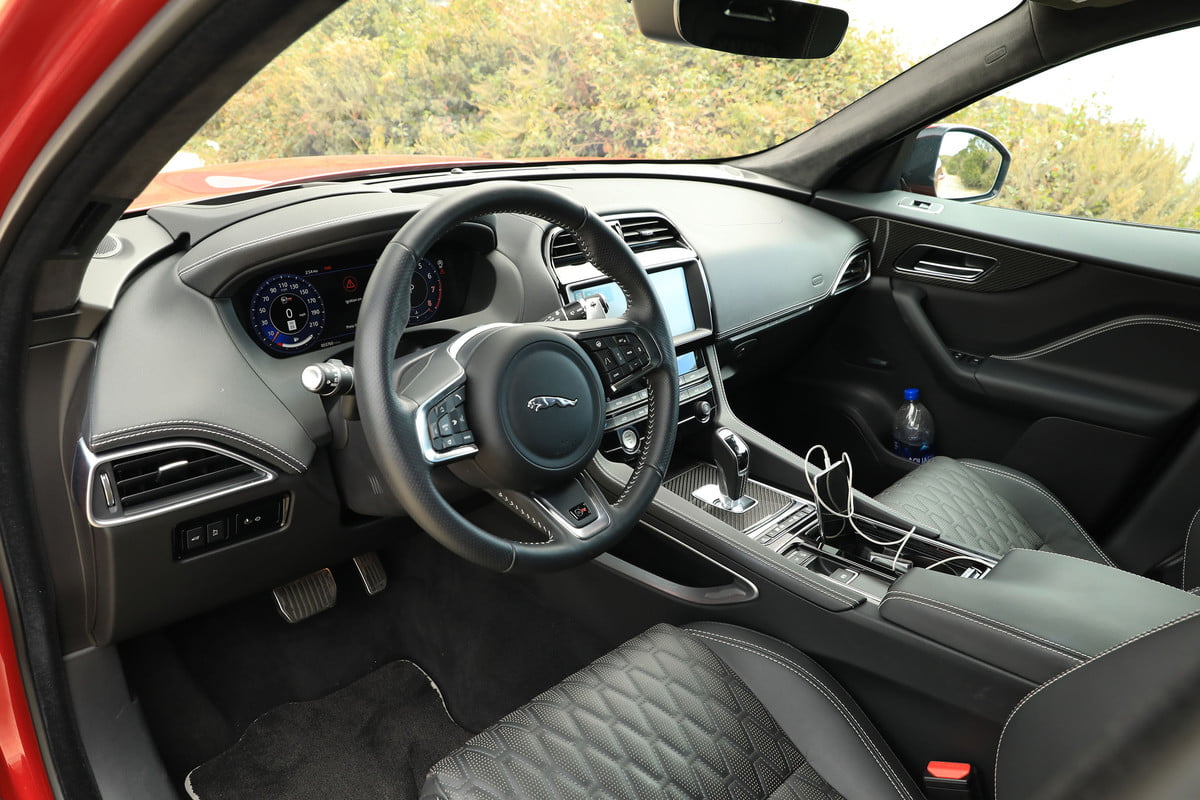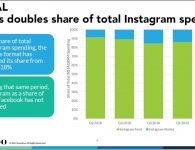

As we were driving away from an impromptu dinner party in a strip mall on the outskirts of Carmel – a brief respite from the wine-and-sport-coat proceedings that comprise the vast majority of soirées during Monterey Car Week – a colleague pulled up alongside us at a stoplight in a McLaren 600LT. Sleek, low, and loud, the Mac is right at home amongst the vast array of exotic machinery you’ll find out and about during this annual celebration of high-end automotive culture.
Lined up and waiting for the tree to drop, I crack a sly grin and give the driver the side eye. I grab for the shifter to put the gearbox in neutral so I can throw a few revs in jest. That’s when it suddenly dawns on me that there’s no shifter to grab, and there’s no revs to be had, because there’s no engine under the hood. You win this round, McLaren.
The I-Pace, Jaguar’s first entry into the EV space, might be a showcase of where the British automaker’s development efforts are headed, but it’s a bit out of its depth amongst the wedge-shaped performance hardware that’s out strutting its stuff all over the Monterey peninsula in mid-August.
The cat we drove up in would have fared better, though. Our steed to and from the Bay Area was the Jaguar F-Pace SVR, a compact crossover that’s motivated by the same rowdy supercharged V8 you’ll find nestled in the engine bay of the F-Type R sports car. The blown five-liter power plant delivers such a raucous soundtrack, Jag installed a volume button for the exhaust right on the center console. C’est la vie.
The Joy Of Conspicuous Consumption
If the I-Pace signals a potential future, the F-Pace represents the here-and-now. Sitting at top of the F-Pace totem pole in terms of performance, features, and style, the SVR is Jaguar’s answer to muscular, sure-footed luxury sport-utilities like the Mercedes-Benz GLC 63 S, Alfa Romeo Stelvio Quadrifoglio, and BMW’s X3 and X4 M models. With crossovers in the midst of usurping sedans and coupes in terms of buyer preference, vehicles like these are playing an increasingly relevant role, in many ways serving as today’s answer to the BMW M5s and Cadillac CTS-Vs of generations passed, offering a pragmatic blend of everyday practicality and sports car capability.


To that end the F-Pace SVR is certainly no slouch, but there’s still room for improvement. Outfitted with a ZF-sourced eight-speed automatic that sends the boosted power plant’s 550 horsepower to all four corners, the SVR will sprint to 60 miles per hour in a manufacturer-claimed 4.1 seconds. That’s definitely sports sedan-fast, but it’s still several ticks behind the aforementioned hot-SUV competition. It’s fortunate, then, that the V8 offers up quite a bit of character. A press of the exhaust button elicits a raspy muscle car growl that’s leagues ahead of the six-cylinder songs of the Alfa and Beemers. The baritone bark of the AMG brings a lot of personality to the table as well, but with a pair of turbochargers muting the proceedings to a tangible degree, it’s a notably more subdued affair.
Jaguar offers an optional summer performance tire for the SVR, but our test car was instead outfitted with all-seasons that set fairly low limits on its mechanical grip. That’s a bit of a shame considering the rest of the chassis upgrades on hand, like adaptive dampers, big six-piston brakes up front, and an active electronic differential with brake-based torque vectoring. At-limit handling notwithstanding, the F-Pace provided a reasonably compliant ride around town in Comfort mode, though the optional 22-inch wheels our tester rolled on did allow some harshness to get through when we encountered potholes and other inconsistencies in the road at speed.
Dialing the drive mode up to Dynamic stiffens the suspension, wakes up the gearbox, and sharpens the throttle response. Bumping the shifter over to Sport mode puts the transmission into an even more aggressive state of mind, and if you choose your own cogs by way of the steering wheel-mounted shift paddles, it will stay in the selected gear indefinitely. It’s a great combination for the winding tarmac of Pacific Coast Highway near Big Sur when you want to keep the engine in the meatiest (and loudest) parts of the rev range.
The SVR also looks the part, with a more hunkered-down stance compared to garden-variety F-Pace models, a quad-tipped exhaust system, chiseled front and rear fascias, and a vented hood. “When do an SVR, we’re allowed to have a little more fun with the vehicle – just turn the dial up to 11,” explained Julian Thomson, Jaguar’s creative design director. “Everything is pumped up, widened, and a bit more functional. But everything is there for a reason – with an SVR, it has to be.”


Though a bit more subdued than the exterior, the cabin is sharp as well, with diamond-stitched sport seats and no shortage of alcantara trim from stem to stern. Eight hundred miles of collective seat time will tell you a lot about what a vehicle is like to live with on a road trip, and in the case of the SVR it’s mostly good news, but there are a few caveats. While the sport seats look great, they’re not particularly supportive laterally due to a lack of thigh bolstering, which kind of defeats the purpose of a performance seat to begin with. And while they’re comfortable enough for brief stints, a multi-hour sessions behind the wheel had our backs hurting no matter how we tweaked the various adjustments, so they ultimately fell short of expectation in both capacities.
Jag’s InControl Touch Pro system and its 10-inch touchscreen are worthy of some praise, but like the seats, you have to take the good with the bad. The display itself is sharp, boasting handsome graphics and a reasonably well-designed menu layout (as well as Apple CarPlay and Android Auto compatibility), but it’s a step behind the best systems on the market today.
Given enough time you’ll acclimate to the cadence of its slightly-delayed input responses, but in 2019, you really shouldn’t have to. That said, it’s ostensibly a CPU upgrade away from its true potential. Wireless CarPlay functionality would be nice, too, considering this crossover commands an as-tested price just shy of $90K.
But at the end of the day, the blown V8 really does make up for a lot. And although it’s not exactly frugal, we managed to get from Monterey to Los Angeles without stopping for fuel, arriving with more than a quarter tank to spare. EPA estimates say the F-Pace SVR will deliver 16 mpg in the city and 21 on the highway, and even with our right foot’s habit of mashing the throttle whenever possible, those figures seem very realistic.
The Quieter, Cleaner Side Of The Coin
The other Jaguar crossover currently making waves is the all-electric I-Pace. As the British automaker’s first foray into EVs, the I-Pace represents what many consider to be the future of the automobile. But whether all-electric machines will enjoy that expected mass adoption remains to be seen, and Jaguar’s decision to provide us seat time in and around Monterey, rather than for the trip to and from LA, highlights one of the key obstacles that still remains. The I-Pace’s 90-kWh battery pack offers a more-than-respectable 240 miles of range, but it’s still not enough to get us through the trip without an overnight pit stop along the way – and that’s assuming you have a Level 2 charger handy. Plug into a standard wall socket and we’re looking at a time frame that extends past a full day.

But that’s a hurdle which certainly isn’t exclusive to Jaguar. Taken within the context of current EV limitations, the I-Pace is a promising first entry. With a dual motor setup that provides 394 horsepower and 512 lb-ft of torque to all four corners, the EV can dash to 60 mph from a standstill in a respectably quick 4.5 seconds, and its adjustable air suspension does an admirable job of hiding the 4800 pounds of girth in the corners as well.
It’s comfortable too, outfitted with far cushier seats than the SVR and a whisper-quiet noise floor that makes its confines a place of serenity rather than drama. And in that way it illustrates how these two vehicles appeal to wholly different buyers: the SVR buyer seeking to merge performance with pragmatism while the prospective EV owner is more focused on the luxury aspects as well as the technological sophistication that underpins the car.

It’s a bit of a bummer, then, that the InControl Touch Pro system is even less responsive here than it is in the F-Pace. Considering the I-Pace’s likelihood of attracting tech-savvy buyers, it seems like the technology that the occupants interact with directly should be state of the art, but instead it’s a reminder of mainstream automakers’ tendency to drag their feet when it comes to technological innovation. When Jaguar updates this infotainment system, the I-Pace should be the first in line to get it.
The Road Ahead
Monterey Car Week is a celebration of the automobile’s past, present, and future. But while automakers pour billions of dollars into the development of electric vehicles, there’s a clear sense that enthusiasts aren’t really chomping at the bit to ditch the dino juice for an electrical outlet just yet. The paddock at Laguna Seca still crackles with the sounds of internal combustion, and Pebble’s lawn will always have oil spots the day after the Concours d’Elegance.
And while the I-Pace is indeed an incredible achievement, I’d be lying if I said I didn’t immediately set the exhaust to ‘loud mode’ when I hopped back behind the wheel of the F-Pace SVR for the trek home. If the current era proves to be the swansong of the internal combustion engine, at least they’re going out with a bang.
In the meantime, while automakers are hard at work creating a sustainable future for motoring, they’d be wise to also put a substantial amount of effort into the emotional aspect of EV design.
If you ever needed evidence that there are still folks among us who consider cars to be more than mere conveyances from Point A to Point B, come to Monterey Car Week. You’ll be hard pressed to find anyone extolling the virtues of regenerative braking, but you’ll hear plenty of revving at the stoplights.
read more at https://www.digitaltrends.com by Bradley Iger
Tech











